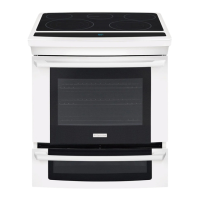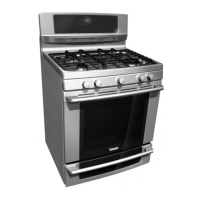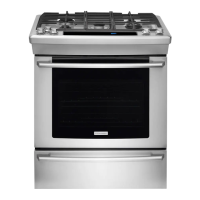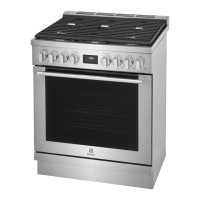Types of cooktop elements
The ceramic glass cooktop has radiant surface elements
located below the surface of the glass cooktop. The
patterns on the ceramic glass will outline the size and type
of element available.
The single radiant element positions will provide one round
outline pattern shown on the cooktop.
The dual radiant element (some models) will provide two
round outline patterns on the cooktop. You may set just the
small inner portion to heat as a single element or both inner
and outer portions of the element may be combined to heat
together as a large element (Fig. 1).
sire
2
OFF
Io hi
o @
Small Large
Element OFF Element
hi hi
6 6
4 4
7 2
4 6 "'"'" """
Sire "o e'" sim
med Io to
Single radiant Dual radiant
surface control surface control
(some models)
Fig. 1
Cookware material types
The cookware material determines how evenly and quickly
heat will transfer from the element to the cookware bottom.
The most popular materials available are listed below.
Aluminum - Excellent heat conductor. Some types of food
will cause it to darken (Anodized aluminum cookware
resists staining & pitting). If aluminum pans slide across the
ceramic cooktop, they may leave metal marks which will
resemble scratches. Remove these marks immediately.
Copper - Excellent heat conductor but discolors easily. May
leave metal marks on ceramic glass (see Aluminum).
Stainless - Slow heat conductor with uneven cooking
results. Is durable, easy to clean and resists staining.
Cast Iron - A slow heat conductor however will retain heat
very well. Cooks evenly once cooking temperature is
reached. Not recommended for use on ceramic cooktops.
Porcelain-enamel on metal - Heating characteristics will
vary depending on base material. Porcelain-enamel coating
must be smooth to avoid scratching ceramic cooktops.
Glass - Slow heat conductor. Not recommended for
ceramic cooktop surfaces because it may scratch the glass.
Using proper cookware
The size and type of cookware used will influence the
setting needed for best cooking results. Be sure to follow
the recommendations for using proper cookware as
illustrated in Figs. 2 & 3.
o
1" 1"
Flat bottom and straight
sides.
Tight fitting lids.
Weight of handle does
not tilt pan. Pan is well
balanced.
Pan sizes match the
amount of food to be
prepared and the size of
the surface element.
Made of a material that
conducts heat well.
Easy to clean.
Always match pot
diameter to element size.
Fig. 2
Cookware should have flat
bottoms that make good contact
with the entire surface heating
element (See Fig. 2). Check for
flatness by rotating a ruler
across the bottom of the
cookware (See Fig. 3).
L_
• Curved and warped pan.
I
..............................Y
u
• Pan larger than cooking area
marked on cooktop by more
than one-half inch or 12mm.
• Heavy handle tilts pan.
I,
• Pan is smaller or larger
than heating area marked
on cooktop.
Fig. 3
Do not place empty aluminum, glass or porcelain-enamel
coated cookware on the ceramic cooktop! The melting
point of some cookware may be reached if left heating on
the cooktop when empty. The cookware can bond to the
ceramic cooktop. If the cookware melts it could damage
the cooktop! Be sure to follow all the manufacturer's
suggestions when using any type of cookware on the
ceramic cooktop.

